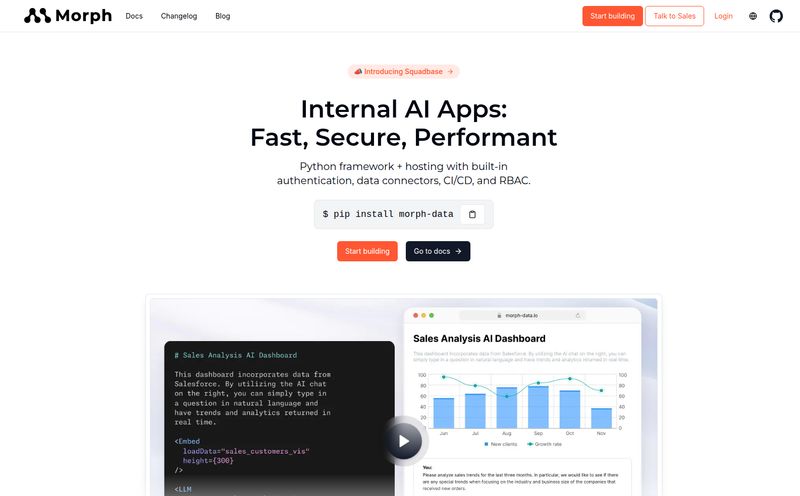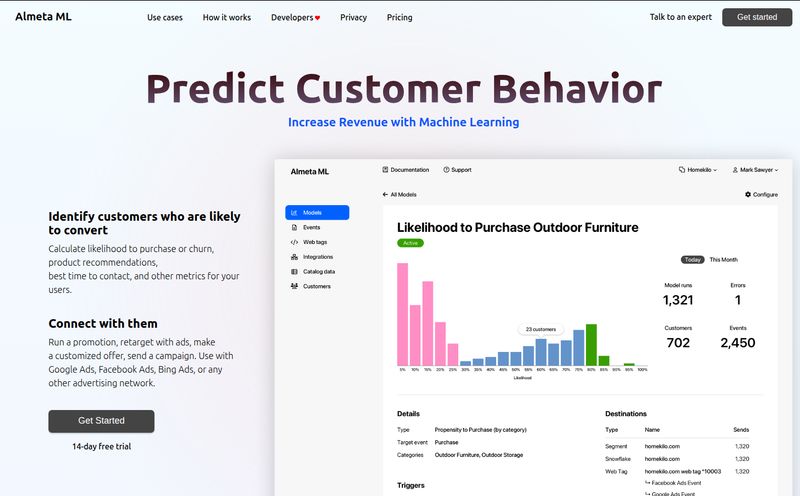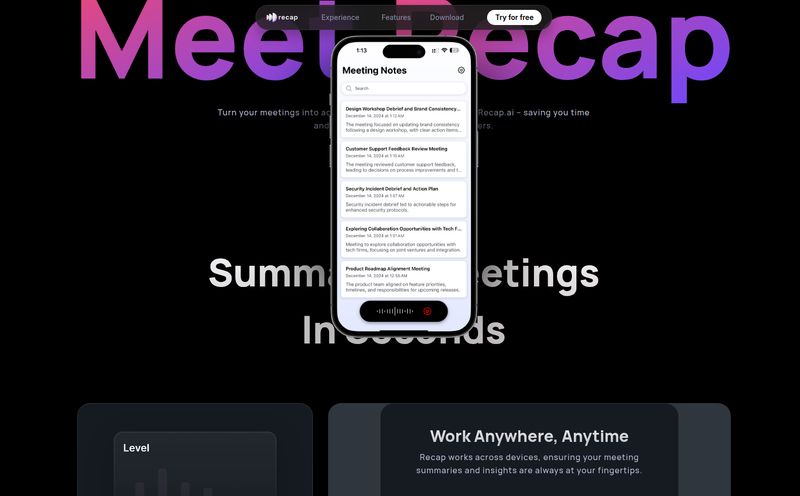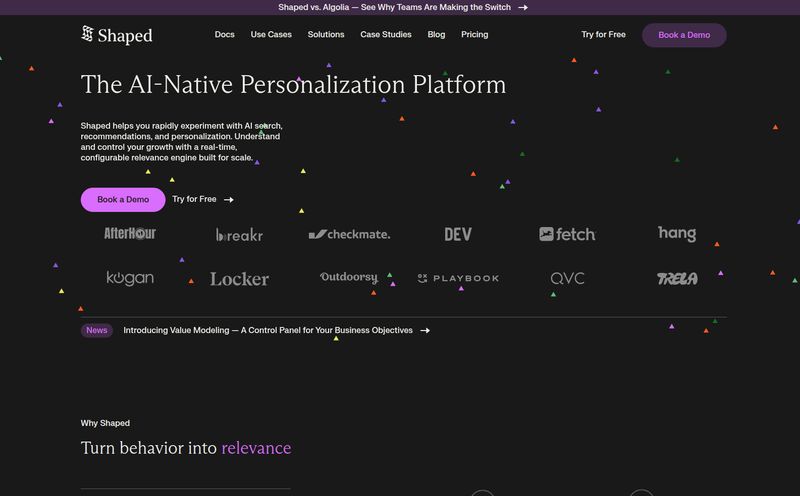If you're in the data world, your workflow probably looks a little… chaotic. I know mine has. You’ve got one tool for pulling data (ETL), another for storing it, a separate BI tool for dashboards, and then you’re hopping over to a Jupyter notebook to actually do the science. It’s a mess of tabs, subscriptions, and compatibility headaches. It feels like you’re trying to build a custom car using parts from a dozen different manufacturers. Sure, it might run, but it’s not pretty and it breaks down a lot.
Every now and then, a platform comes along that claims to fix all that. A tool that promises to be the mythical “all-in-one” solution. Most of the time, I'm skeptical. But recently, I stumbled upon Dflux.ai, and I have to admit, my curiosity is piqued. It calls itself a unified data science platform, and from what I've seen, it's making a pretty compelling case.
So, What is Dflux.ai Anyway?
Think of Dflux.ai as a central command center for your entire data operation. Instead of juggling a half-dozen different apps, it aims to bring everything under one roof. We’re talking about connecting to your data sources, cleaning and preparing the data (the not-so-glamorous data engineering part), building predictive models, and creating interactive dashboards to show off your findings. All in one place.
The big idea here is to finally bridge that frustrating gap between a company's data strategy and the actual data science. It’s designed to let you go from raw, messy data scattered across different databases to a clean, automated pipeline that feeds directly into business decisions. It’s a bold promise, but one that any data pro can get behind.
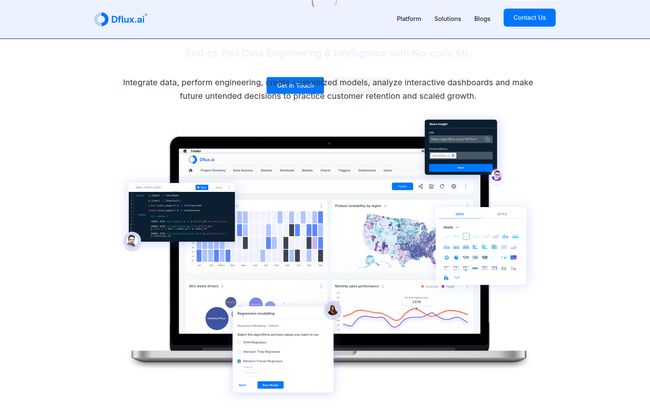
Visit Dflux.ai
Breaking Down the Silos with a Unified Approach
The single biggest headache in modern data analytics is the silo effect. The engineers have their tools, the analysts have theirs, and the data scientists are off in their own corner with theirs. Dflux seems to be built specifically to tear down those walls.
From Raw Data to Insight in Record Time
The platform’s workflow is pretty logical. You start by connecting to your data—wherever it lives. Then you move into the engineering and preparation phase. This is where you can optimize data pipelines and get everything ready for analysis. Finally, you can explore the data, build models, and deploy dashboards. By keeping it all in one environment, you cut out the painful export/import/reformat dance that wastes so much time.
The Magic of No-Code and Pro-Code Flexibility
Here’s where things get interesting. Dflux has a heavy focus on “no-code ML.” This is huge. It means a business analyst or a marketing manager, someone who understands the business questions but doesn’t write Python, can actually start building predictive models. That’s democratizing data science in a very real way.
But—and this is a big but—it doesn't abandon the experts. For the seasoned data scientists who want to get their hands dirty, Dflux has integrated Python notebooks. So you get the best of both worlds. You can use the easy drag-and-drop stuff for quick tasks, and then dive into custom code when you need to. It’s a smart way to cater to the whole team.
The Standout Features That Caught My Eye
Every platform has its bells and whistles, but a few of Dflux’s features really stood out to me as genuine time-savers and productivity boosters.
AutoML for Everyone
If you’re not familiar with AutoML, think of it as having a tireless data science intern. You give it a clean dataset and tell it what you want to predict (like customer churn or sales figures), and it automatically builds, trains, and tests dozens of different machine learning models for you. It then presents the best-performing one. This used to be a highly technical, time-consuming process. Now, it's becoming a push-button affair, and Dflux has put it front and center. It dramatically speeds up the journey to a working model.
Truly Interactive Dashboards
We've all seen dashboards that are little more than pretty, static pictures. Dflux seems to understand that a good dashboard is a tool for exploration, not just a report. The idea is to build visualizations that you can drill into, ask new questions of, and get answers from on the fly. This turns reporting from a passive activity into an active conversation with your data.
AI-Powered Text to SQL is a Game Changer
Okay, this one is just cool. For anyone who has spent hours trying to remember the exact SQL syntax for a complex join, this is a lifesaver. You can literally type a question in plain English, like “Show me the total sales for our top 5 products in the last quarter, grouped by region,” and the AI builder generates the SQL query for you. It's not just a gimmick; it’s a massive barrier to entry being torn down. It lets people focus on the question they want to ask, not the code they need to write. Its a genuine productivity multiplier.
Who Is This Platform Really For?
Based on its feature set, Dflux is casting a wide net, and I think it lands well for a few key roles:
- Data Engineers: The automated pipeline and easy integration features will be a breath of fresh air. Less time on manual scripting and maintenance, more time on architecture.
- Data Analysts: The text-to-SQL and intuitive dashboarding tools are perfect. It empowers them to answer deeper questions without needing to constantly bug engineers or data scientists for help.
- Data Scientists: The combination of AutoML for speed and Python notebooks for depth is the sweet spot. It handles the repetitive work, freeing them up to focus on the truly complex modeling challenges.
- Decision Makers: For a manager or executive, having a single source of truth where they can see performance and forecasts in one clear dashboard is invaluable.
The Elephant in the Room: Dflux.ai Pricing
Alright, let's talk about money. Or, in this case, the lack of a public price tag on their website. If you go looking for a pricing page, you won’t find one. Now, don't panic. This is actually pretty standard for enterprise-level B2B software.
The reasoning is usually that there's no one-size-fits-all price. The cost likely depends on the number of users, the scale of your data, and the specific features you need. They want you to contact them so they can put together a custom package. While I always prefer transparent pricing, this approach does suggest they're more focused on creating a tailored solution than just selling a generic product off the shelf. You'll have to reach out for a demo and a quote.
My Honest Take: The Good and The Potential Hiccups
No tool is perfect, so here's my balanced view. The big win for Dflux is clearly its all-in-one, unified nature. The potential to streamline a messy workflow into a single, cohesive process is immense. The efficiency gains from features like AutoML and text-to-SQL are undeniable, and it makes powerful data science more accessible than ever.
On the flip side, the biggest potential hurdle is the one that comes with any powerful, feature-rich platform: a learning curve. While the no-code aspects are designed for simplicity, mastering the entire platform and all its capabilities will probably take some time. It's not a tool you'll become an expert on in an afternoon, but the most powerful tools rarely are.
Frequently Asked Questions about Dflux.ai
Is Dflux.ai good for complete beginners?
Its no-code features make it one of the more accessible data science platforms out there. A business user with strong domain knowledge could definitely get value from the dashboards and text-to-SQL features. However, to use its full power, some background in data concepts is beneficial.
Can I use my own Python scripts and libraries in Dflux?
Yes. Dflux includes integrated Python notebooks, which means data scientists can bring in their own custom code and preferred libraries, giving them the flexibility they need for complex tasks.
How does Dflux.ai handle data security?
While specifics would come from a direct demo, the platform emphasizes a 'safe and secured' environment. Enterprise-grade platforms like this typically have robust role-based access controls, encryption, and compliance features to ensure data is protected.
What kinds of data sources can I connect to Dflux?
The platform is designed to connect to a wide array of data sources, from traditional SQL databases and data warehouses to cloud storage and APIs. The goal is to ingest data from wherever it currently resides.
Does Dflux replace tools like Tableau or Power BI?
It can. Dflux has its own powerful, interactive dashboarding capabilities. For a team looking to consolidate its tech stack, Dflux could certainly serve as a replacement for a standalone BI tool.
The Final Verdict
So, is Dflux.ai the platform we’ve all been waiting for? In my opinion, it's one of the strongest contenders I’ve seen in a while. It’s not just another tool; it’s an attempt to fix a fundamentally broken process. It addresses the real-world pain points of data teams who are tired of duct-taping systems together.
If you're a data leader looking to bring sanity to your team's workflow, or an analyst who wants to do more without learning to be a full-stack developer, Dflux.ai is absolutely worth investigating. It seems to have found that rare balance between power for the experts and accessibility for everyone else. And in the world of data, that’s a pretty incredible feat.
Reference and Sources
- Dflux.ai Official Website
- Gartner Magic Quadrant for Data Science and Machine Learning Platforms (Illustrates the industry trend toward unified platforms)
